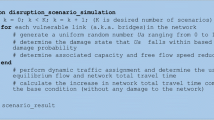Abstract
In a disaster situation, functionality of an infrastructure network is critical for effective emergency response. We evaluate several probabilistic measures of connectivity and expected travel time/distance between critical origin–destination pairs to assess the functionality of a given transportation network in case of a disaster. The input data include the most likely disaster scenarios as well as the probability that each link of the network fails under each scenario. Unlike most studies that assume independent link failures, we model dependency among link failures and propose a novel dependency model that incorporates the impact of the disaster on the network and at the same time yields tractable cases for the computation of the probabilistic measures. We develop algorithms for the computation of the measures and utilize a Monte Carlo simulation algorithm for the intractable cases. We present a case study of the Istanbul highway system under earthquake risk, and compare different dependency structures computationally.
Similar content being viewed by others
References
Auerswald P, Branscomb LM, La Porte TM, Michel-Kerjan E (2005) The challenge of protecting critical infrastructure. Issues Sci Technol 22: 77–80
Ball MO, Colbourn CJ, Provan JS (1995) Network reliability. Handbooks OR & MS 7: 673–762
Black WR (1992) Network autocorrelation in transport network and flow systems. Geograph Anal 24(3): 207–222
Buchsbaum AL, Mihail M (1995) Monte Carlo and Markov Chain techniques for network reliability and sampling. Networks 25: 117–130
Carey M, Hendrickson C (1984) Bounds on expected performance of networks with links subject to failure. Networks 14: 439–456
Chang SE, Nojima N (2001) Measuring post-disaster transportation system performance: the 1995 Kobe earthquake in comparative perspective. Transp Res Part A 35: 475–494
Chang SE, Shinozuka M, Moore JE (2000) Probabilistic earthquake scenarios: extending risk analysis methodologies to spatially distributed systems. Earthq Spectra 16(3): 557–572
Chen A, Yang H, Lo HK, Tang WH (2002) Capacity reliability of a road network: an assessment methodology and numerical results. Transp Res Part B 36: 225–252
Eppstein D (1994) Finding the k-shortest paths. In: 35th Annual symposium on foundations of computer science, pp 154–165
Garg M, Smith JC (2008) Models and algorithms for the design of survivable networks with general failure scenarios. Omega 36: 1057–1071
Griffiths JHP, Irfanoglu A, Pujol C (2007) Istanbul at the threshold: an evaluation of the seismic risk in Istanbul. Earthq Spectra 23: 63–75
Grossi P, Kunreuther H, Patel CC (2005) Catastrophe modeling: a new approach to managing risk. Springer, New York
ISMEP (2010) Istanbul seismic risk mitigation and emergency preparedness project. Technical report, The World Bank Project ID P078359, report no. 53705. http://www.worldbank.org.tr
Jenelius E, Petersen T, Mattson LG (2006) Importance and exposure in road network vulnerability analysis. Transp Res Part A 40: 537–560
JICA-IMM (2002) The study on a disaster prevention/mitigation basic plan in Istanbul including microzonation in the Republic of Turkey. Technical report, Japanese International Cooperation Agency, Local Municipality of Istanbul, Final report, vol V, Sept 2002
Karger DR (1995) A randomized fully polynomial time approximation scheme for the all-terminal network reliability problem. In: The twenty-seventh annual ACM symposium on the theory of computing. ACM Press, pp 11–17, June 1995
Konak A, Smith AE (2006) Network reliability optimization. In: Resende MGC, Pardolos PM (eds) Handbook of optimization in telecommunications, XXXII. Springer, New York, pp 735–760
Lawler EL (1972) A procedure for computing the k best solutions to discrete optimization problems and its application to the shortest path problem. Manag Sci 18: 401–405
Lin Y (2003) Extend the quickest path problem to the system reliability evaluation for a stochastic-flow network. Comput Oper Res 30: 567–575
Lin Y (2010) On transmission time through k-minimal paths of a capacitated-flow network. Appl Math Model 34: 245–253
Matisziw TC, Murray AT (2009) Modeling s − t path availability to support disaster vulnerability assessment of network infrastructure. Comput Oper Res 36: 16–26
Matisziw TC, Murray AT, Grubesic TH (2009) Exploring the vulnerability of network infrastructure to disruption. Ann Reg Sci 43(2): 307–321
Moghtaderi-zadeh M, Kiureghan AD (1983) Reliability upgrading of lifeline networks for post-earthquake serviceability. Earthq Eng Struct Dyn 11: 557–566
Noyan N (2010a) Two-stage stochastic programming involving CVaR with an application to disaster management. http://www.optimization-online.org/DB_FILE/2010/03/2571.pdf. Accessed 14 Oct 2010
Noyan N (2010) Alternate risk measures for emergency medical service system design. Ann Oper Res 181(1): 559–589
Parsons T, Toda S, Stein RS, Barka A, Dieterich JH (2000) Heightened odds of large earthquakes near Istanbul: an interaction-based probability calculation. Science 288: 661–665
Peeta S, Salman FS, Gunnec D, Viswanath K (2010) Strengthening the links of a transportation network for disaster response effectiveness. Comput Oper Res 37: 1708–1719
Perrow C (2007) The next catastrophe: reducing our vulnerabilities to natural, industrial, and terrorist disasters. Princeton University Press, Princeton
Pflug GC, Romisch W (2007) Modeling, measuring and managing risk. World Scientific, Singapore
Selcuk SA, Yucemen SM (2000) Reliability of lifeline networks with multiple sources under seismic hazard. Nat Hazards 21: 1–18
Sohn J (2006) Evaluating the significance of highway network links under the flood damage: an accessibility approach. Transp Res Part A 40: 491–506
Sumalee A, Kurauchi F (2006) Network capacity reliability analysis considering traffic regulation after a major disaster. Netw Spatial Econ 5: 205–219
Sumalee A, Watling D (2003) Travel time reliability in a network with dependent link modes and partial driver response. J Eastern Asia Soc Transp Stud 5: 1687–1701
Taylor MAP, Sekhar SVC, D’Este SMD (2006) Application of accessibility based methods for vulnerability analysis of strategic networks. Netw Spatial Econ 6: 267–291
Yen JY (1971) Finding the k-shortest loopless paths in a network. Manag Sci 17: 712–716
Author information
Authors and Affiliations
Corresponding author
Rights and permissions
About this article
Cite this article
Günneç, D., Salman, F.S. Assessing the reliability and the expected performance of a network under disaster risk. OR Spectrum 33, 499–523 (2011). https://doi.org/10.1007/s00291-011-0250-7
Published:
Issue Date:
DOI: https://doi.org/10.1007/s00291-011-0250-7




